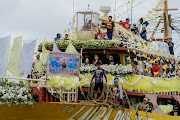THE NEGROS MUSEUM
What is now the entrance along Gatuslao Street in Bacolod City, where one sees the imposing unfluted column shafts, used to be the back of the Agricultural Extension Building. Once upon a time, a short road ran between the back of The Negros Museum and what is now the Negros Forest. This was the original entrance to the government-owned building and words in bas relief (Agricultural Extension Building Bacolod MCMXLI) welcomed visitors for decades until the agricultural office moved.
.jpg) BAO: the Unbowed Carabao, a sculpture done by Rafael Paderna and mosaic artist Lisa de Leon-Zayco, a gift from the Angelica Berrie Foundation, stitches together the chapters of this once agricultural extension building, turned Negros Museum.
BAO: the Unbowed Carabao, a sculpture done by Rafael Paderna and mosaic artist Lisa de Leon-Zayco, a gift from the Angelica Berrie Foundation, stitches together the chapters of this once agricultural extension building, turned Negros Museum.
Credit is given to Architect Antonio Toledo, one of the first six registered architects in the Philippines (1921) for creating an edifice that takes advantage of natural light, and relies on natural air circulation to cool the lower and upper floors.
The staircase construction is a thing of beauty and function. The steps, including the descanso (landing), all perfectly climax in “oro”. They are molded from a mixture of cement and aggregates, a speckled contrast to the recurrent square theme of the Machuca tiles, yet in harmony with the tiles’ predominantly chestnut color. A series of west-facing windows allow ample illumination on the three flights of stairs and also washes over the lobby (now Gallery B) to be met by more light through the three front doors at the original entrance. The bottom staircase that races west separates into two after the first descanso and both curve back to continue to the east, an element preferable in Philippine native architecture because the sun rises in the east.
 A Kenneth Cobonpue chandelier is featured prominently above the staircase, a gift from Negrense Angelica Urra Berrie.
A Kenneth Cobonpue chandelier is featured prominently above the staircase, a gift from Negrense Angelica Urra Berrie.
The white interiors of the building is given an interesting texture above the staircases with a Kenneth Cobonpue chandelier that, though expansive, gives an impression of lightness. The sculptural lighting art piece is a gift from Angelica Urra Berrie. Through the years Negrenses have contributed to the restoration of the museum, including Jose Marie Chan. Governor Eugenio Jose Lacson leads the provincial government of Negros Occidental in supporting The Negros Museum.
Text by: Betsy Gazo
Photos by: Bem Cortez

.png)









